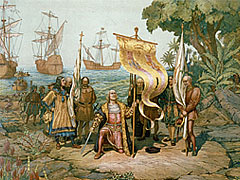The Renaissance is the epoch of the idealistic „rebirth“ of man, inspired by the classical antiquity, where the human being was the measure of all things. In parallel with this „rediscovery“ of man the important modern discoveries are made: The discovery of America in 1492, the first circumnavigation of the world, the establishment of the natural sciences influenced by such figures as Kopernikus, Galilei, Kepler, and the invention of the letterpress by Gutenberg around 1455. The examination of nature and history begins, the common, popular languages enter literature and art. Religious battles, the reform work of Luther and the counterreformation with the Council of Trient 1545-63 reflect the new self-confidence of man.
 A collection of polyphonic hymns and Magnificats by Costanzo Festa; this is the earliest surviving such collection by a single composer in the Vatican archive
A collection of polyphonic hymns and Magnificats by Costanzo Festa; this is the earliest surviving such collection by a single composer in the Vatican archive
The orientation on antiquity leads to a new simplicity in architecture, abandoning the gothic ideal. In the fine arts the focus of reference is on the human being, an idealized naturalness is the aim, leading to the development of perspective representation and the creation of freestanding sculptures. In spite of the lack of antique models music change as well, simple melodies structured by the flow of the human breath become the ideal. Now artists create music to imitate nature, to accompany the text in vocal music, to support and reflect its content.
The contemporary musicians travel far and wide and extend the French-Gothic vision of the Burgundian composers with many English and Italian influences. Around 1430 the ars nova originates, characterized by a plain simplicity.
Polyphonic vocal music is predominant, only hesitantly instrumental music develops an independency. Polyphony is still literally a sum of contrapunctally formed individual parts, converging in a continuous vocalization. Fluent melody and a continuous imitation within a movement, colorful thirds and sixths and pre-tonal triadic harmony change the sound ideal of the Renaissance. In the end the chord emerges, basis for the figured bass of the Baroque.
Other characteristics of the music of the Renaissance are: The English Fauxbourdon (sixth chord), four-part texture (standard at the end of the 15th century), the development of tonal cadenza, the parody (use of worldly song melodies instead of liturgical chants). The polytextual structure of the motet is given up in favor of a better understanding of content. Prevalent in Mass is the four-part tenor Mass of the Dutch vocal polyphony, performed choric and often purely vocal, but increasingly accompanied by instruments that simply join the choral parts. In the course of the 16th century the Italian madrigal as a new worldly genre of importance is created, in addition to the French chanson, which roots in the troubadour tradition of the Middle Ages.
 A depiction of Columbus claiming possession of the New World in a chromolithograph made by the Prang Education Company in 1893.
A depiction of Columbus claiming possession of the New World in a chromolithograph made by the Prang Education Company in 1893.
 A session of the Council of Trent, from an engraving.
A session of the Council of Trent, from an engraving.
The time around 1500 distinguishes itself by an especially artistic application of the contrapunctual composition skills, sometimes seeming to be an end in itself. The following epoch tries to regain a more profound clarity, lucidity and simplicity, the general expression follows the text.
Instrumental music still serves as accompaniment for song and dance, as background and entertainment. Autonomy is not achieved until the 16th century when the vocal genres and their compositional principles are transcribed for instruments. The Italian organ school develops the form of the toccata, the prelude and the ricercar, the early form of the fugue. The favorite domestic instrument of the era is the lute, which accompanies song and dance and on which the earliest compositions for instruments are performed.